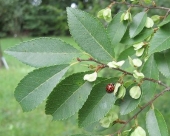I hear a lot of bad things about this tree and how it's roots will spread so far it can become problematic for piping, other plants, for all sorts of things.
However, I have a yard with a chinese elm in it. The roots haven't spread very far, best I can tell. I can eat the new leaves and the small flower/seeds that it has, although the only shade it gives is to my neighbors. This tree has been here the entire time I have, 9 years, and is about the same size it was when I moved in (maybe 15-20 feet tall, but skinny still, no big canopy). I'm in an arid desert with alkaline soil, 12 inches of rain a year, and temperatures up to 117 F. And I'm wondering if the soil, the low rain (I almost never water this thing), or the climate is keeping it small.
If I improve the soil and start harvesting water more in the area around this tree, and the soil becomes a little less alkaline, could this tree become problematic? I am honestly wondering if I should let this tree alone, or if it will really be a problem for the desert food forest I am hoping to grow and I should chop it down for mulch. Any thoughts? Information on this tree? Experiences with Chinese Elm?
I'd appreciate any help ya'll might be able to provide.









